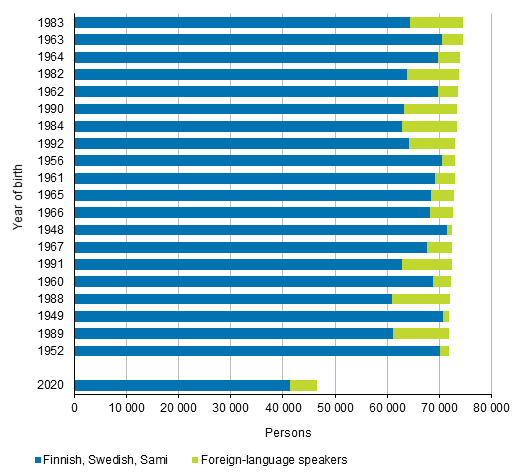Published: 31 March 2021
Foreign-language speakers helped maintain population increase
According to Statistics Finland's statistics on population structure, the official total population of Finland at the end of 2020 was 5,533,793. In the course of 2020, Finland’s population grew by 8,501 persons. The relative population increase was 0.2 per cent. The number of persons speaking Finnish, Swedish or Sami as their native language went down by 11,702 persons, and the number of foreign-language speakers grew by 20,203 persons.
Change in the population by native language in 1981 to 2020

Nearly 433,000 foreign-language speakers, over 84,000 Russian native language speakers
A total of 432,847 persons speaking a foreign language as their native language were living permanently in Finland at the end of 2020. The proportion of foreign-language speakers in the total population is eight per cent. The biggest foreign-language speaking groups were Russian speakers, 84,190 persons, Estonian speakers, 49,551, and Arabic speakers, 34,282.
Examined by region, the share of foreign-language speakers was at the end of 2020 highest in the region of Uusimaa, 15 per cent of the population, and lowest in South Ostrobothnia, two per cent.
Russian native language speakers are the largest foreign-language group in the regions apart from the regions of Kanta-Häme and Ostrobothnia and the Åland Islands. In Kanta-Häme, the largest foreign-language speaking group is those speaking Estonian as their native language and in Ostrobothnia, the largest foreign-language speaking group is those speaking Vietnamese as their native language. In Åland those speaking Romanian as their native language.
Examined by municipality, the share of foreign-language speakers among the population was highest in Vantaa, 22 per cent, in Espoo, 19 per cent, and in Närpiö and Helsinki, 17 per cent.
Of the 309 municipalities in Finland, Russian was the largest foreign-language speaking group in 151 municipalities.
Foreign-language speakers increased population in Greater Helsinki, Kouvola lost most
The biggest absolute increase in population was seen in Vantaa, 3,456 persons, in Helsinki (3,085) and Espoo (3,065). The population growth in Greater Helsinki was entirely based on the foreign-language speaking population, because the number of persons speaking national languages decreased in Greater Helsinki during 2020. The number of persons speaking national languages also decreased in the region of Uusimaa.
During 2020, the population grew in 89 and diminished in 220 municipalities. In 2019 just 54 municipalities increased their population.
Number of municipalities having increased their population by year in 1951 to 2020

Regional division of 1 Jan 2021
Examined in relative terms, the population grew in Mainland Finland most in Kauniainen (3.9 per cent) and Kaskinen (2.6 per cent) and in Sipoo and Kempele (2.4 per cent).
In absolute numbers, the population decreased most in Kouvola, by 926 persons, and in Mikkeli, by 551 persons. In Mainland Finland, the largest relative decreases in population occurred in Siikainen (3.6 per cent) and Hyrynsalmi (3.2 per cent).
Number of persons aged 100 or over exceeded the 1,000 mark
The number of persons aged over 100 in the population exceeded 1,000 during 2020. At the end of the year they numbered 1,038, of whom 152 were men and 886 women. The number of persons aged 100 or over grew by as many as 130 persons during 2020.
Number of persons aged 100 or over by sex in 1972 to 2020

Largest birth cohort in the population is those born in 1983
During 2020, those born in 1983 became the largest age group in our population. At the end of 2020, in all 74,548 such persons were living in Finland. The second largest birth cohort, those born in 1963, totalled 74,540 persons.
Biggest birth cohorts in the population and the 2020 birth cohort by native language at the end of 2020

Immigration has helped raise those born in 1983 to the largest age group. Around one in seven of those born in 1983 who lived in Finland were foreign-language speakers. In 1983, 66,892 children were born in Finland, so the age group of those born in 1983 is now nearly 8,000 bigger despite mortality and emigration.
If the birth cohorts were examined only by the number of speakers of national languages, the largest birth cohort among the population would be those born in 1948.
The small size of the age groups born in 2020 and 2019 is clearly visible in that these birth cohorts were the 77th and 78th biggest in the population. For example, there were more persons born in 1941 in the population at the end of 2020 than persons born in 2020 or 2019.
Source: Population Structure 2020, Statistics Finland
Inquiries: Markus Rapo 029 551 3238, info@stat.fi
Head of Department in charge: Hannele Orjala
Publication in pdf-format (350.5 kB)
- Tables
-
Tables in databases
Pick the data you need into tables, view the data as graphs, or download the data for your use.
Appendix tables
- Figures
-
- Appendix figure 1. Population in Finland 1750 - 2020 (31.3.2021)
- Appendix figure 2. Population by age 1972 - 2020 (31.3.2021)
- Quality descriptions
-
- Quality description: Population structure 2020 (31.3.2021)
Updated 31.3.2021
Official Statistics of Finland (OSF):
Population structure [e-publication].
ISSN=1797-5395. 2020. Helsinki: Statistics Finland [referred: 28.12.2025].
Access method: http://stat.fi/til/vaerak/2020/vaerak_2020_2021-03-31_tie_001_en.html

